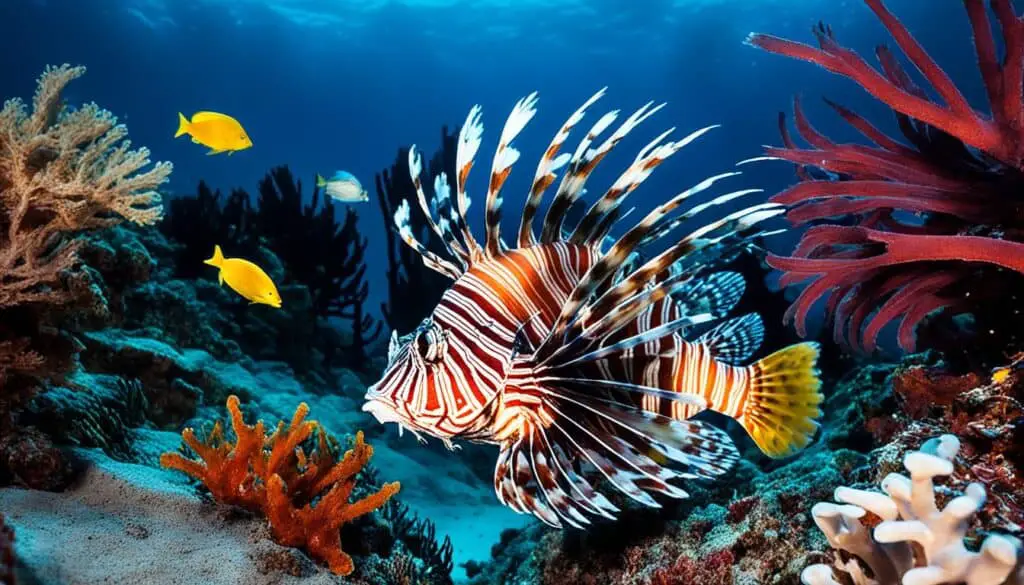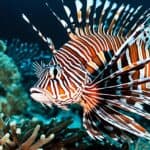Lionfish, known as Pterois volitans and Pterois miles, are both beautiful and dangerous. They raise questions about safety in the water. You might find them stunning, but it’s important to know the risks they bring. These fish are carnivorous and venomous, but they usually don’t attack humans. However, their sharp, venomous spines can cause painful stings.
This article will look into whether lionfish are a threat to humans. We’ll cover important lionfish facts and explain their biology and risks.
Lionfish Basics
Lionfish are both beautiful and dangerous in the water. They have unique traits and live in certain places. This makes them an interesting species to learn about.
What Are Lionfish?
Lionfish are part of the scorpionfish family. They stand out with their bright colors. Originally from the Indo-Pacific, they have moved to other areas quickly because they reproduce fast and adapt well. Their venomous spines help protect them from predators.
Physical Characteristics of Lionfish
Lionfish have eye-catching looks. Their bodies are covered with long, flowing fins in colors like brown, maroon, or white. These colors help them blend in with their surroundings. Key features of lionfish include:
- Long, spiky fins
- Striped coloration
- Venomous dorsal spines
Native Habitat and Distribution
Lionfish live in the Indo-Pacific, from coral reefs to rocky seabeds. They have also moved to the Western Atlantic, Caribbean, and Gulf of Mexico. A map showing their spread highlights where they live and the risks they bring. Humans and nature have helped them spread, through aquarium releases and natural movement.
| Region | Native Habitat | Invasive Areas |
|---|---|---|
| Indo-Pacific | Coral reefs, rocky environments | Western Atlantic, Caribbean, Gulf of Mexico |
| Caribbean | Seagrass beds, reef systems | Florida Keys, Bahamas |
| Gulf of Mexico | Various underwater structures | Texas, Louisiana |
Understanding Lionfish Venom
Lionfish venom is a complex substance that affects humans and marine life. It comes from spines that act as a toxin when they touch something. Knowing how this venom works helps us understand its effects.
How Does Lionfish Venom Work?
When a lionfish stings, it injects venom through its spines. This venom messes with the target’s nervous system. It causes symptoms like:
- Intense pain
- Swelling
- Nausea
- Possible severe systemic reactions
The effects of the venom depend on where and how deep the sting is. Knowing how it works helps us treat and prevent stings.
Differences Between Venom and Poison
It’s important to know the difference between venom and poison when talking about lionfish. Here’s what sets them apart:
| Feature | Venom | Poison |
|---|---|---|
| Method of Delivery | Injected directly into the target | Requires ingestion or inhalation |
| Purpose | Used for defense or predation | Typically a defense mechanism against predators |
| Examples | Snake venom, lionfish venom | Poisonous frogs, some mushrooms |
Understanding the difference between venom and poison helps us see lionfish in their natural setting. It also shows how they interact with humans.
Are Lionfish Dangerous to Humans?
Lionfish are beautiful but can be a risk to humans. Their venomous spines protect them, causing painful stings when people touch them by accident. It’s important to know about lionfish stings for those who dive, snorkel, or keep them in tanks.
The Nature of Lionfish Stings
Lionfish sting when they feel threatened, even though they’re usually not aggressive. The sting hurts a lot and can have different symptoms. People who dive or snorkel might get stung by these fish. Knowing about the effects of lionfish stings is key.
Incidence of Stings and Injury Reports
How often people get stung by lionfish depends on where they live and how much they interact with them. Some stings are minor and can be treated at home. But, others can cause serious issues like:
- Infection
- Low blood pressure
- Temporary paralysis
Knowing the signs of a lionfish sting helps in getting treatment faster. This can reduce the risks.

| Symptoms of Lionfish Stings | Severity Level |
|---|---|
| Pain at the sting site | Mild to Severe |
| Swelling and redness | Mild |
| Nausea and vomiting | Moderate to Severe |
| Difficulty breathing | Severe |
| Temporary paralysis | Severe |
Meeting lionfish can be dangerous, showing why we need to be careful around them.
Symptoms and Effects of Lionfish Stings
Knowing the signs of a lionfish sting is key to staying safe in places where they live. When you get stung, you might feel a lot of pain right away. Spotting these signs early helps you get the right treatment and ease the pain.
Common Symptoms of a Lionfish Sting
A lionfish sting usually causes a lot of pain where it happened. This area might get soft and swell up. You could also feel headaches and get sick as your body deals with the venom. If you see these signs, you should act fast to stop things from getting worse.
Severe Reactions and Potential Complications
Most people get better from lionfish stings without big problems. But, some can get worse fast. People with health issues or allergies might have serious issues like infections or heart problems. Knowing how to treat lionfish poison is key to avoiding these risks and getting better quickly. Being aware of these risks helps you stay safe around lionfish.
FAQ
Are lionfish dangerous to humans?
Yes, lionfish are dangerous to humans because of their venomous spines. They usually don’t attack, but touching them can cause painful stings.
What are the symptoms of a lionfish sting?
Symptoms include a lot of pain, swelling, and tenderness at the sting site. You might also feel nauseous or have headaches. Some people could get worse reactions or infections.
How can you treat a lionfish sting?
To treat a sting, put the affected area in hot water to ease the pain. Clean it well and watch for signs of infection. If it’s very bad, you should get medical help.
What are lionfish facts I should know?
Lionfish originally come from the Indo-Pacific but are now in the Western Atlantic too. They multiply fast and have few enemies, which hurts local marine life.
What does lionfish venom do?
Lionfish venom is a toxin that attacks the muscles and nerves. It causes a lot of pain, swelling, and other effects. Knowing about it helps understand how serious a sting can be.
What control methods are used to manage lionfish populations?
To control lionfish, people use spearguns, organized fishing events, and teach people to eat lionfish. This helps reduce their numbers in places they shouldn’t be.
What is the impact of the lionfish invasion?
Lionfish taking over has caused big problems for local marine life. They take over food and space, which harms the variety of life in the water.
Are there differences between venom and poison?
Yes, venom comes from a bite or sting, while poison is eaten or put into the body on purpose. Knowing the difference helps you react right to stings.
Can lionfish stings cause severe reactions?
Most stings are not too bad, but people with health issues might have big problems. This includes heart issues or temporary paralysis.
Where can I find a lionfish distribution map?
You can find maps showing where lionfish live through marine research groups and conservation organizations. These maps show how they’ve spread from their original home to new places in the Atlantic and Caribbean.







